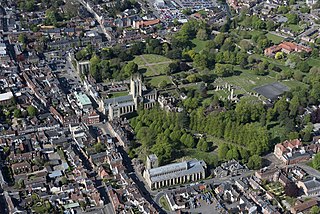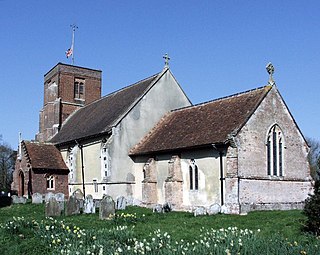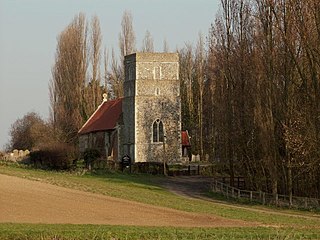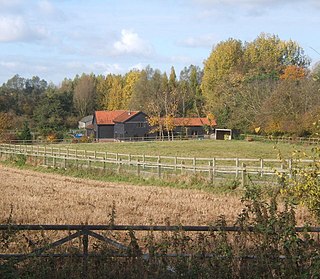
Bury St Edmunds, commonly referred to locally as Bury, is a cathedral as well as market town and civil parish in the West Suffolk district, in the county of Suffolk, England. The town is best known for Bury St Edmunds Abbey and St Edmundsbury Cathedral. Bury is the seat of the Diocese of St Edmundsbury and Ipswich of the Church of England, with the episcopal see at St Edmundsbury Cathedral. In 2011, it had a population of 45,000. The town, originally called Beodericsworth, was built on a grid pattern by Abbot Baldwin around 1080. It is known for brewing and malting and for a British Sugar processing factory, where Silver Spoon sugar is produced. The town is the cultural and retail centre for West Suffolk and tourism is a major part of the economy.

The American Civil War was the most widely covered conflict of the 19th century. The images would provide posterity with a comprehensive visual record of the war and its leading figures, and make a powerful impression on the populace. Something not generally known by the public is the fact that roughly 70% of the war's documentary photography was captured by the twin lenses of a stereo camera. The American Civil War was the first war in history whose intimate reality would be brought home to the public, not only in newspaper depictions, album cards and cartes-de-visite, but in a popular new 3D format called a "stereograph," "stereocard" or "stereoview." Millions of these cards were produced and purchased by a public eager to experience the nature of warfare in a whole new way.

Metfield is a village and civil parish in the Mid Suffolk district, in Suffolk, England, but its name is derived from Medefeld or 'Meadow feld'. It is situated close to the border with Norfolk, being approximately 5 miles south east of Harleston and 7 miles north west of Halesworth. The population was estimated to be 370 in 1996, increasing to 388 at the 2011 Census.

Badley is a village and civil parish in the Mid Suffolk district, in Suffolk, England. It is located between Stowmarket and Needham Market. With an electorate of less than 100, it has an infrequent parish meeting rather than a parish council. Badley is listed as a settlement with 41 households in the 1086 Domesday Book. In 1901 the population was 77, and the parish covered 1 050 acres.

Akenham is a village and civil parish in the Mid Suffolk district of Suffolk in the East of England. Located on the north-western edge of Ipswich, in 2005 it had an estimated population of 60. At the 2011 Census the population remained less than 100 and was included in the civil parish of Whitton.

Ampton is a village and civil parish in the West Suffolk District of Suffolk, England, about five miles north of Bury St Edmunds.

Ashbocking is a village and civil parish in the Mid Suffolk district of Suffolk, England. The village is about seven miles north of Ipswich, and according to the 2001 census had a population of 318, increasing to 356 at the 2011 Census.

Battisford is a village and civil parish in the Mid Suffolk district of Suffolk, England. The village is about 4 miles (6 km) south of Stowmarket, and is directly alongside Wattisham Airfield.

Stradishall is a village and civil parish in West Suffolk in the English county of Suffolk. It is five miles North West of Clare and nine miles North East of Haverhill.

St Mary's Church is the civic church of Bury St Edmunds in Suffolk, England and is one of the largest parish churches in England. It claims to have the second longest nave, and the largest West Window of any parish church in the country. It was part of the abbey complex and originally was one of three large churches in the town.

Creeting St Mary is a village and civil parish in the Mid Suffolk district of Suffolk in eastern England. Sandwiched between the A14 and A140 to the north of Needham Market, the parish also includes the hamlet of Creeting Bottoms. In 2005 the parish population was 710, which decreased to 697 at the 2011 Census.

Ringshall is a village and civil parish in the Mid Suffolk district of Suffolk in eastern England. Located around four miles south of Stowmarket, and 13 miles north west of Ipswich.

Frank Jay Haynes, known as F. Jay or "the Professor" to almost all who knew him, was a professional photographer, publisher, and entrepreneur from Minnesota who played a major role in documenting through photographs the settlement and early history of the Northwestern United States. He became both the official photographer of the Northern Pacific Railway and of Yellowstone National Park as well as operating early transportation concessions in the park. His photographs were widely published in articles, journals, and books, and turned into stereographs and postcards in the late 19th and early 20th century.

Swilland is a village and civil parish, in the East Suffolk district, in the English county of Suffolk. It is north of the large town of Ipswich. Swilland has a church called St Mary's Church and a pub called The Moon & Mushroom Inn which has been awarded Suffolk Pub of The Year on two occasions by the Evening Star. Swilland shares a parish council with Witnesham called "Swilland and Witnesham Grouped Parish Council".

Brightwell is a village and civil parish in the East Suffolk district, in the English county of Suffolk. It is located 7 miles east of Ipswich and 4 miles south west of Woodbridge. Adjacent parishes include Foxhall, Bucklesham, Martlesham and Newbourne. There is the A12 road nearby.

Ampton Hall is a Grade II-listed Jacobean style manor house in Ampton, Suffolk, England.

Moyse's Hall is a building in the Suffolk town of Bury St Edmunds. It is a Grade I listed building and is thought to have been originally built circa 1180. It is probable but not certain that it was a Jewish merchant's house. In 1895, before it became a museum, part was in use by the Great Eastern Railway as a Parcel Receiving and Enquiry Office, with another section being incorporated into the Castle Hotel. It has also been used as the town's jail, police station, and as a workhouse.

Creeting All Saints is a former civil parish, now in the parish of Creeting St Mary, in the Mid Suffolk district, in the county of Suffolk, England. It was once located in Bosmere and Claydon Hundred. The parish church used to share a churchyard with Creeting St Mary until it was damaged beyond repair by a storm in 1800. The ruins were demolished in 1813. Nothing remains of the old church and much of the masonry has been reused in the church of Creeting St Mary. However the old font was installed in the Holy Trinity Church, Stowupland. In 1881 the parish had a population of 300. On 25 March 1884 the parish was abolished and merged with Creeting St. Mary.

St Mary's Church is the parish church for Preston St Mary, in the county of Suffolk, England. Originally built in the 14th century it suffered lightning damage in 1758, and was substantially restored by Arthur Blomfield in 1868. It is a Grade I listed building.
Robert Ryece (1555–1638) was an English antiquary who wrote A Breviary of Suffolk in 1618, a book which was not published until 1902.



















